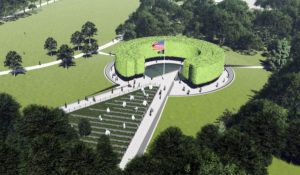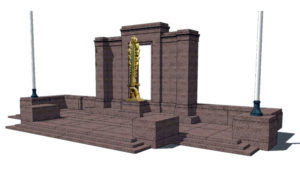By Tom King
Here are the comments I filed on October 29, 2019 via the National Park Service website, concerning the proposed modifications to the Korean War Veterans Memorial on the National Mall and the 2nd Infantry Division Memorial in President’s Park south of the White House. I serve as an informal advisor to the National Mall Coalition regarding historic preservation matters, based on my 50-year checkered career in and around the federal government. I think my comments are consistent with those of the Coalition, though they are obviously different.
I’m writing to comment on the proposals to modify the Korean War Veterans Memorial and the 2ndInfantry Division Memorial on the National Mall in Washington DC. By way of background: I’m a U.S. Navy veteran (active duty 1961-63); my late father served in the Navy in World War II, and my late brother served in the Korean War. My oldest grandson is now preparing to serve. My late wife lost her father to enemy action during World War II.

I have lived in the Washington DC area since 1979, variously employed by the Advisory Council on Historic Preservation (ACHP) and as a contractor to the Departments of Agriculture and Defense, the General Services Administration, and the Department of Veterans Affairs. I am a regular visitor to the National Mall, and am privileged to participate informally as an advisor to the National Mall Coalition on matters pertaining to Section 106 of the National Historic Preservation Act, in which I have specialized for the last 50+ years.
I was glad to sit in on the October 15 meetings at the offices of the ACHP to discuss the areas of potential effect (APEs) and likely effects of the two modification projects, pursuant to the ACHP’s regulations (36 CFR Part 800).
Both projects are relatively small in scale, and their direct effects are likely to be modest. Both, however, have the potential for indirect effects that will develop over time, which need to be considered.
In the case of the Korean War Veterans Memorial, much of the discussion on October 15 circulated around the question of how to keep people from walking up onto the berm and looking down on people scanning the memorial plaques for the names of loved ones. I had the rather awful vision of antique veterans in wheelchairs waving canes and lobbing invective at kids squatting on the berm flinging some latter-day version of frisbees around. Presumably such outcomes can be prevented only through vigorous supervision by Park Police, which raises additional ugly possibilities.
This is a microcosm of an issue with which the National Mall Coalition wrestles regularly: to what extent is the Mall a place for the nation’s people to enjoy themselves amid monuments, and to what extent is it a place of monuments that people are supposed to venerate? These are issues fundamental to the character of the Mall as a public place and as a complex of historic properties.
Read the National Mall Coalition’s comments submitted on the Korean Veterans Memorial and the Second Division Memorial.
The 2nd Division Memorial seems to me to present almost the flip-side of the same issue. Here is a structure that since the 1930s people have experienced mostly from afar, viewing it from Constitution Avenue. The proposed modifications would make the Memorial much more accessible, via new pathways, steps, and handicap access ramps. Is this a good thing, or is it not? Will we have lost something precious if the 2ndDivision’s flaming sword becomes something not necessarily seen shimmering in the distance, but something one can walk up to? I don’t know the answer, but it’s something that must be considered, and it was gratifying to learn that the architect is considering it. I hope NPS will, as well.
In any event, both these indirect effects have the potential to be adverse, by virtue of “diminish(ing) the integrity of the property’s location, … setting, …. feeling, or association” (36 CFR §800.5(a)(1). I realize that one may quibble that the Korean War Veterans Memorial isn’t exactly an historic property, so the criteria of adverse effect are irrelevant, but I trust that NPS will not stoop to such a quibble. The Memorial certainly does contribute to the plethora of historic districts that collectively comprise the National Mall.
A more direct effect of the proposed wall at the Korean War Veteran’s Memorial is that it changes the Memorial’s essential character from one that commemorates the first great military venture of the United Nations into one that focuses, a la the Viet Nam War Veterans Memorial, on the American dead. This may or may not be a wise change, but it is inescapably a change that has the potential to diminish the integrity of the Memorial’s location, setting, feeling and association, and hence an adverse effect.

A quite direct adverse effect of the proposed 2ndDivision Memorial expansion is the plan to carve the whimsical names of recent U.S. military actions into its plinths. Beginning, I think, in 1990 with “Operation Desert Shield,” someone in the military chain of command seems to have decided that it would be a good idea to assign “meaningful” names to operations (as opposed simply to code names like “Operation Overlord”). Thus we have gotten “Operation Enduring Freedom” and “Operation Iraqi Freedom.” The names seem to become sillier and more jingoistic with every passing decade, and it’s predictable that if they’re carved on the plinths, the plinths will in time become objects of ridicule. Dates, places, and a simple tribute to the dead should be sufficient; to add operation names would, in the words of the regulations, “change … the character of … physical features within the property’s setting that contribute to its historic significance (36CFR §800.4(b)(iv)) and introduce “visual … elements that diminish the integrity of the property’s significant historic features” (36 CFR §800.4(b)(v)).
Finally, both projects contribute to a pattern of cumulative impact to which NPS really needs to attend. This is what the Coalition has aptly referred to as the militarization of the Mall. The Mall is many things to many different people, and it serves many public purposes. Serving those purposes is essential to its character. In my forty years experience with the Mall, it has seemed at its best as a lively place, full of people enjoying its cultural resources and amenities. It has been a place of demonstration, of celebration, of festivals and fireworks and face-offs. It has contained monuments, yes, and sometimes rather battered trees and grass, but it has not been a static place where we walk in silence from monument to monument, mourning our dead or glorying in our greatness – unless, of course, that’s what we want to do at the moment. In recent years, however, more and more of the Mall has gotten locked up in military memorials – Viet Nam, Korea, World War II, the Eisenhower Memorial with its focus on Normandy, and now in the works, memorials to our recent and ongoing adventures in Iraq and Afghanistan, and even to the “international war on terror.” Congress seems never to meet a war memorial that it isn’t willing to fund – though it is apparently unwilling to give NPS the money it needs to maintain them all very well. Being an archaeologist, I can envision a day when the Mall looks like the Roman Forum, where you can’t turn around without bumping into a monument to some emperor’s triumph or conquest. Since we don’t seem to be able to contain our enthusiasm for wars, we really at least need to give serious thought to whether, where, and how they should be commemorated.
Learn more about these two memorial modifications at the National Park Service planning website:
Korean War Veterans Memorial
Second Division Memorial
• Tom King is a free-lance writer, cultural anthropologist, and historic preservation consultant.
Tags: Korean War Veterans Memorial, monument, National Park Service
